CHASING THE WHITE DRAGON - HEROIN
Manipulation, bribery, murder and war are the weapons of drug barons, world leaders, governments and some religions in the heroin-related drug wars. Heroin is yet another illegal commodity for empire building, money and power. In a book by Bill Bonanno, a former Mafia boss, he wrote that Robert Kennedy's murder was an act of irritation from mob kingpin Sam Giancana, because of the government's crusade against the Mafia. They felt betrayed after delivery of their pledge to his father, Joseph Kennedy, to help win the elections in 1960. The US government fought the Vietnam War to preserve its lucrative cut of Southwest Asian heroin traffic. In the One World magazine a write up of the film Opium: Dealing with the Demon examines in detail the story of opium and its history. Heroin manufacturing (the second largest industry in the world) in the Golden Crescent involves connections between the CIA, the 151, Mujahideen, the collapsed BCCI bank and Pakistan's nuclear weapons programme. ( http://www.envirolink.org/oneworld/seek/deamon/intro.html ). According to varied reports the Kosovo Liberation Army (KLA) is financed by drug money. According to the banned book Dope Incorporated ( Boston Bankers and Soviet Commissars; by the Editors of Executive Intelligence Review) the British Empire was mainly responsible for Chinese addiction to heroin. Germany 's Federal Criminal Agency in the Times March 1999 reported: "Ethnic Albanians are now the most prominent group in the distribution of heroin in Western consumer countries."
September 1999. SAPS Forensic Science Laboratory (FSL) in Pretoria reported an increase in heroin-related cases in all the provinces except in the Cape, according to Supt Casper Venter (SAPS Forensic Science Laboratory (FSL)) in Kuilsrivier.
The increase of heroin found in illegal drug trafficking seems to be a worldwide tendency. Time Daily, August 24, 1999 reported that three tonnes of cocaine and heroin are moved across the border into the US each month. Hungarian Interior Minister Sandor Pinter told Reuters in 1999 that 1-2 kg of drug shipments were found occasionally in the past, but today it sometimes exceeds 100 kg of heroin. According to the BBC online network in October 1998, Burma was facing heroin explosions and devastating epidemics of heroin addiction and HIV infection. In Russia heroin happens to be the drug of choice at the moment. In Moscow 's Narcological Hospital , the largest hospital for drug abusers in Russia , 80% of its patients are heroin users. Figures in 1998 indicate 1.7 million heroin addicts in Pakistan. Most addicts turn to crime to fund their costly habit. Cabinet Office Minister, Jack Cunningham in London said that last year - heroin and crack drug addicts had been responsible for 30% of all the crime in Britain. In South Africa heroin use is prevalent among people accused of non-drug-related charges (Rocha Silva L, Drug use in South Africa, 21 May 1998).
In March 1999 SANAB Pretoria seized heroin from school children - a first in this city's history. The International Narcotics Control Board (INCB) said heroin abuse was becoming a serious problem in South Africa (Mail & Guardian, March 6, 1997). Rehabilitation centres in Cape Town, Port Elizabeth and Gauteng report more and more addicts of which the primary drug of abuse is heroin (Parry C, Dec 1999, SACENDU).
Celebrities are not excluded from the destruction of heroin. In April 1994 Kurt Cobain, lead singer of the Seattle-based alternative rock band, Nirvana, died of heroin-related suicide. Eric Clapton said he was so addicted to alcohol and heroin in the 70s that he raped his wife. A 17-year-old soccer player in England admitted to suffering from a serious heroin addiction. Heroin shooting in images like those seen in the film Pulp Fiction shows the perception of this addictive drug as becoming more commercial.
Heroin within Opiates
Heroin (Diacetyl morphine/Diamorphine) is an opiate. Opiates can be classified as follows: Natural opiates are the natural constituents of opium, such as morphine, codeine and thebaine. Semi-synthetic opiates are altered natural products. These are the products of chemically treated natural opium constituents such as heroin, Hydromorphone (Dilaudid), Oxycodone and Hydrocodone. Synthetic products are wholly produced in a laboratory. The effects are similar to those of the opium derivatives, although they don't contain any of the derivatives. Examples of synthetic products are Meperidine, Fentanyl, Pentazocine, Methadone (Dollies) which are distributed to addicts in clinics as a substitute for heroin and dipipanone (Wellconal/Pinks). Collectively opiates and synthetic opiates are called opioids.
History
In 3400 BC the opium poppy was cultivated by Sumerians in lower Mesopotamia and was referred to as Hul GiI (Joy plant). The plant with its euphoric effects soon found its way to the Assyrians. The art of poppy culling was passed from the Assyrians to the Babylonians, who, in turn, passed their knowledge on to the Egyptians. Poppy seed was used as a medicine and recreational drug amongst the ancient Greeks and by the 7th or 8th century AD, it was commonly used in Chinese medicine. Arab traders took opium to China. The Portuguese, while trading along the East China Sea , indicated the smoking of opium in 1500.
Most Chinese opium was imported into China from India by the East India Company. In other words a British company was the main supplier to China using opium grown in conquered lands in India and the British government benefited greatly from the tax revenue. This led to "Opium Wars" in 1839 and 1856. The result was that Chinese authorities made opium use legal and began to grow their own poppies. In time China became a main supplier for opium use n Europe . Opium was used in Europe in medicines from the 1550s and by the 17th century drugs like laudanum (opium dissolved in alcohol) were used for all sorts of ailments, including pain and coughs.
Morphine was first synthesised from opium in 1805 by a German chemist. Thousands of soldiers in the American Civil War came home addicted to morphine. In 1874 Germany , heroin was first synthesised from morphine - again it was advertised as non-addictive, this time as a substitute for morphine. Commercial production of the new pain remedy was started in 1898. By the late 1920s heroin was the most widely abused opiate worldwide and the mid 1970s saw the beginning of a significant market in illegally manufactured heroin.
Today heroin is one of the top three main addictive substances on the market. Since the first international attempts to control illicit drugs in 1909 In Shanghai, the world has been facing levels of heroin production unprecedented in recent history.
The plant of joy
Papaver somniferum L. Common names: Opium, poppy, mawseed. The vast majority of opium poppies are grown In the Golden Triangle (Myanmar/Burma, Thailand and Laos) in Southeast Asia and the Golden Crescent (Iran , Afghanistan and Pakistan) in Southwest Asia, Turkey, Lebanon and Colombia, Guatemala and Mexico in Latin America. Afghanistan, according to United Nations figures, produces 45% of the world's opium need, more than 2 000 tonnes. It seems as if the Colombian cartel saturated the market with cocaine and began to grow poppies. According to the US Drug Enforcement Agency figures, Colombia produces about 80% of the world's cocaine and supplies up to 60% of the high grade heroin sold on the east coast of the United States .
  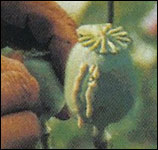
There are several varieties of the opium yielding poppies of which Persian White has the largest bulb and subsequently the highest yield. This plant thrives/flourishes in dry, warm climates. The opium poppy is an annual plant: only one crop per year can be grown in areas with distinct seasons hot and cold, wet and dry - but cultivation can be year-round in more favourable climates. The seasonal nature of opium cultivation, the fact that seeds take three months to transform into blooming flowers, the sensitivity of the fragile crops to the whims of the weather, plus other variables like opium prices and labour availability, can cause production to fluctuate from year to year much more than is typical of coca cultivation.
The flower is grown mainly by impoverished farmers on small plots in remote regions of the world. Most of the time the farmers' land holdings are too small to cultivate alternative crops that can compete with growing lucrative opium poppies. Some call opium the golden crop - cheap to cultivate and lucrative when harvested. In India it is called Black Gold.
Flower of joy conversion to H
The transformation process from poppy to heroin is long and labour-intensive. The flowers, which later expose an egg-shaped seed pod, have inside them the crudest form of opium in an opaque milky form (latex) obtained by making an incision on the unripe seed capsule with a special curved knife. The oozing sap turns darker and thicker, forming a brownish-black gum, which is collected and wrapped in plastic or leaves or formed into bricks, cakes or balls. A black market broker buys this and the packages are transported to a morphine refinery - most of the time no more than a rickety "laboratory" set up with oil drums shrouded in a jungle thicket.
The opium is mixed with lime in boiling water. When the precipitate of organic waste sinks to the bottom, a white band of morphine forms on the surface, which is drawn off, reheated with ammonia, filtered and boiled until reduced to a brown paste. This is poured into moulds and dried in the sun. The morphine base, with the consistency of modelling clay, is ready for processing through a complex chemical process into the final product, a fluffy white powder, in the trade known as "number four heroin". Every ten tonnes of raw opium produce up to one tonne of heroin.
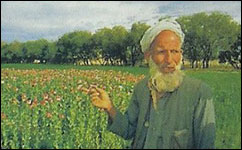
In these remote laboratories, using rudimentary equipment, the heroin powder is pressed into bricks for bulk shipment to destination countries. Smaller amounts are smuggled, for example, by couriers who swallow heroin filled latex balloons or condoms (bullets) before boarding commercial airlines.
Appearance of street heroin
Heroin is an illegal opiate drug, known on the street as brown sugar, dope, horse, skunk, Hermina, magic dragon, smack, junk, smack (Yiddish schmecker meaning taste), brown, mud, black tar, H, Gear, boy, dragon, harries, tiger, powder, Harry, Thai white or shit.
 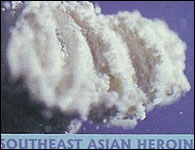
Pure heroin is found in the form of a white powder or granules like cat litter with a bitter taste. Because of impurities left behind from the manufacturing process or the presence of additives including a wide variety of possible dilutants, adulterants and alkaloids, the colour will differ from white to dark brown. A snatch is approximately 0.1 g -1 g of heroin wrapped in a plastic bag of 5 cm x 5 cm, rolled up and knotted and the ends are burned together. Dealers place it in their mouths, which makes it easy to swallow when the law is on their heels. To increase the bulk of the material sold to the addict, dilutants are mixed with the heroin in ratios ranging from 9 to 1 to as much as 99 to 1. Sugars, starch, Bisto, colouring agents, cocoa, brown sugar, powdered milk, glucose, caffeine, flour, talcum powder and quinine are among the dllutants used. The purity of each individual batch of heroin is unknown and buyers depend on the reputation of the distributor.
Black tar is a crudely processed form of heroin illicitly manufactured in Mexico . It may be sticky like roofing tar or hard like coal, and it is dark brown to black in colour. Black tar is often sold on the street in its tar-like state, sometimes with 40% - 80% purity. This form of heroin is sometimes diluted, however, by adding materials of similar consistency (such as burnt cornstarch) or by converting the tar heroin into a powder and adding conventional dilutants, such as mannitol or quinine. It is most commonly used through injection.
In South Africa , more white than brown heroin is seized but brown heroin is still the king. According to Supt Casper Venter especially in the Cape brown heroin (brown sugar) is favoured. This is a mixture of heroin and uppers and downers like phenobarbital, caffeine, diazepam and trimetropiem.
Prices vary widely depending on buyer-seller relationship, the quantities purchased, purchase frequencies and transportation costs. In South Africa one gram is sold for between R300 and R400.
Administration
Heroin can be taken orally, smoked and snorted but is normally injected intravenously IV (mainlining), intramuscularly (IM) or subcutaneously (under the skin/skin-popping).
Chewing heroin gum is not a common way of administering the drug, except in the Golden Triangle because of its availability. Injection is the practical and efficient way to administer low-purity heroin. Heroin is mixed with water and citric acid in a spoon and heated until it becomes a clear brown solution. The solution is drawn up in a syringe, often using a cigarette filter to filter out impurities.
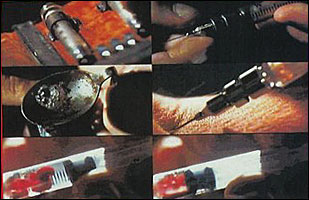
The availability of higher purity heroin has meant that users can now snort it like cocaine. Smokable heroin was rediscovered in the 1980s and caused a dramatic increase in use, because it was no longer necessary to inject the drug in order to take it.
Smoking appealed to newcomers because of AIDS and the historical stigma attached to intravenous heroin use. It promoted heroin from a ghetto drug into the middle class with a much larger target market. Chasing the white dragon/puff the white dragon are street terms to describe a way of smoking heroin. It usually involves placing powdered heroin on aluminium foil and heating it from below with a lighter. The heroin turns to a sticky liquid and wriggles around like a Chinese dragon. Fumes are given off and are inhaled sometimes through a rolled up newspaper, magazine or tube. Heroin can also be smoked by using a pipe (Hubble Bubbly) or a glass tube, much like the use of crack.
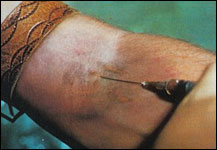 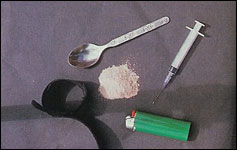
Opioids made for medical use come in tablet or injectable form and may be used for non-medical reasons if heroin addicts can't get hold of heroin. Because of a shortage of heroin in New Zealand , addicts extract codeine from the mixtures and convert it chemically to heroin. In South Africa pethidine, alcohol/ethanol, barbiturates, tranquillizers or other opiates that increase the depressant effects of each drug and increase the risk of an accidental overdose are used. Cocaine used with heroin is called speedball.
Dosage & effects
Effects are the same whichever way of administration is used. Sniffing or snorting has a mild effect and works within seven seconds, while smoking and injecting give the highest satisfaction and have an effect within between 15-30 seconds. Effects start with a rush (great feeling of relaxation) for two minutes followed by a high (warm, drowsy, cosy state) lasting for 4-5 hours. Effects depend on the dosage, routes of administration, previous exposure to the drug and the expectations of the user.
The first effect is a short-lived state of euphoria (general sense of well-being by reducing tension, anxiety and aggression) followed by drowsiness, nausea and vomiting. The user has a slow irregular heart rate and blood pressure and respiratory depression which can lead to a coma. The neural activity in the brain is slowed down which causes reduced physical activity/reflexes, apathy, reduced appetite, increased tolerance of pain, suppressed cough reflex, decreased sexual desire and inability to concentrate. The user has pinpoint/constricted pupils, droopy eyelids and impaired night vision. The dilation of the subcutaneous blood vessels causes flushing of the face and neck. Constipation is common. Most women users experience menstrual irregularity and addiction in pregnant women tends to result in premature, stillborn or addicted infants who experience withdrawal symptoms. Other symptoms are impaired immunity and hair loss. The sniffing of heroin causes damage to the mucous membrane and a dry itching skin where heroin is injected.
The use of heroin causes injury to the retina of the eye and kidney failure from infections and adulterants in the drug. Shared needles and impurities directly introduced into the bloodstream can cause septicaemia (bacteria in the blood stream) with infection and/or abscesses in every organ in the body and vireamie (viruses in the blood), for example AIDS. Blood clots can develop because of the damage to veins which can lead to pulmonary embolism and death.
Heroin causes severe physical addiction: tolerance develops quickly and doses must be constantly decreased to produce the desired effects. Addicts have been killed by the same dose which was readily tolerated the day before. The psychological dependency is complex and protracted. Addicts experience powerful psychological craving. Long after the physical need they will still think and talk heroin. You can get addicted pretty quickly and start feeling you have to have it all the time. It's cut with all sorts of rubbish but you don't really care. The only goal in life becomes getting more. It kind of took all my feelings away - heroin user. It can take months or even years to recover from the physical addiction the psychological addiction is a lifetime battle.
The intensity and character of the physical symptoms experienced during withdrawal are directly related to the particular drug of abuse, the total daily dose, the interval between doses, the duration of use and the health and personality of the addict in general. The first withdrawal signs are usually experienced shortly before the time of the next scheduled dose, between 4-12 hours after the last dose. Early symptoms (between 8-12 hours after the last dose) include watery eyes, runny nose, yawning and sweating. Restlessness, irritability, anxiety, insomnia, loss of appetite and concentration, tremors, severe sneezing; chills and goose bumps (may explain the term cold turkey, as goose bumps all over the body resemble a plucked turkey) appear as the syndrome progresses. I feel like I'm gonna jump out of my skin "cold turkey", an addict quitting heroin. Severe depression and vomiting are common and irregular heart rate and blood pressure are also characteristic symptoms. Pains in the bones and muscles of the extremities occur, as do muscle spasms and kicking movements, which may be the source of the saying kicking the habit. Most of the physical symptoms will disappear in seven days. Insomnia can last for months.
Summary
The prices that farmers get for their alternative, legal crops are nothing compared to that which is received for drugs like opium. Opium is often grown in inaccessible areas where law enforcement is impossible. It is said that it takes 20 square miles of land to grow enough opium poppies to supply every junkie in America with a year's worth of heroin. America 's true drug crisis has erupted among adults in their 30s and 40s, the age group parenting teens. Kids raised in these families will be far more likely to abuse drugs themselves. Nobody knows exactly what quality heroin she/he is buying on the street. The higher purity currently available on the street results in the typical heroin user today consuming more heroin than a typical user did just a decade ago and it may also be a sign of a higher level of global production. Younger people experiment with heroin. It doesn't seem as if the world has had any success in curbing the illicit drug trade of heroin. But the living hell of the heroin user can last a lifetime. A user may overcome the addiction to heroin, but end up with AIDS. Will the purchasing power of the global money spinner, black gold, always be attractive to some of the people pulling the strings?
The information in this article has been transcribed verbatim from the following publication:
Servamus – Community edition – Drugs and Occult Related Crime – The Facts – The Answer.
We express our heartfelt gratitude for permission to replicate these articles on this website.
Published by:
SARP Publishers
Private Bag X24
Elardus Park
0047
South Africa
Editor: Annalise Kempen
Tel: +27 (0)12 345 4622 / 4660
Fax: +27 (0)12 345 5627
Cell: +27 (0)83 269 3513
Email: annalise@servamus.co.za
Web: www.servamus.co.za
For copies of this excellent and significant publication, please contact Servamus at the above contact details. |

